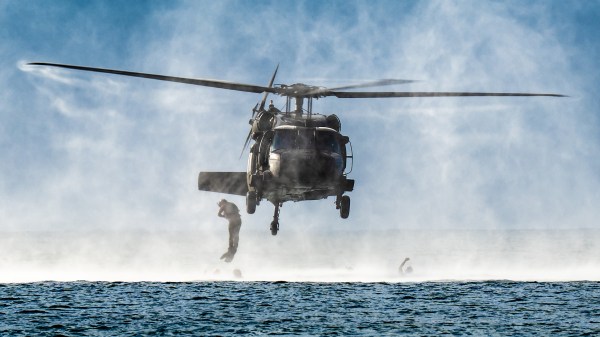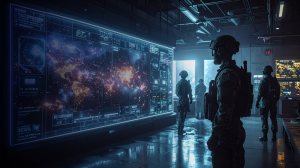Special ops will look to invest in new technologies to compete with advanced nation-state actors

As the Department of Defense has reoriented to prioritize competition with nation-states over counterterrorism, special operations forces are undergoing a transformation to figure out what it means to meet that directive while maintaining their global counterterrorism mission.
“We’re transforming the SOF enterprise to achieve the goals of the” National Defense Strategy, Christopher Maier, assistant secretary of defense for special operations and low-intensity conflict, told the Senate Armed Services Committee on March 7. “While SOF’s role in counterterrorism is widely understood and appreciated, my team and I work daily to ensure the value proposition of SOF in integrated deterrence and campaigning against strategic competitors is accounted for and incorporated into the department’s processes.”
Integrated deterrence is a key pillar of the recently released National Defense Strategy and articulates a more coordinated approach across government and with allies and partners.
Officials explained that special operations forces are seeking to balance three main missions of counterterrorism, crisis response and, now, integrated deterrence against nation-states in a period of what the department calls strategic competition.
“It’s is a balance. Some of those tools are interchangeable. We can bring them across the spectrum,” Gen. Bryan Fenton, commander of Special Operations Command, told senators. “We’ll reinforce the capabilities we have in the counterterrorism arena transfers well over into our integrated deterrence approach.”
This comes in the form of partnerships with other nations to train their forces. By being forward, it allows special operations forces unique “placement and access” that can be taken advantage of by other forces, such as providing unique remote or electronic access in the digital realm, while also being able to get a leg up on beating back potential aggression. This was the case with Ukraine in its battle against Russian invaders.
“We still will continue from the SOF enterprise to do counterterrorism and crisis response and there’s some lessons from that that are very applicable. We will continue to work by, with and through partners, we will continue to focus on placement and access, sometimes through those partners, sometimes through our own exquisite capabilities unilaterally,” Maier said days later at a House Armed Services Subcommittee hearing on March 9.
The ongoing transition also largely means heavier investments in advanced technologies.
“I think what we will need to focus on more is if we are indeed working across all domains; some of those domains have broadened from what was applicable in the fight against Al-Qaeda and ISIS. So space, cyber has already been mentioned, the ability to recognize that the world is one that operating without being seen is particularly challenging,” Maier said. “We need more tactics, techniques and procedures that allow us to do that. We also need more technology that allows us to do that in a very technologically enabled world.”
Maier explained that special operations forces are going to need capabilities that can operate in so-called non-permissive environments, especially when it comes to advanced intelligence, surveillance and reconnaissance platforms. During the counterterrorism years, U.S. forces largely enjoyed air superiority and were able to fly persistent surveillance missions against insurgents.
Now, sophisticated actors will be able to sense, jam and even shoot down these assets. As a result, special operations forces are looking for next-generation capabilities.
“Next-Generation ISR enables finding and fixing a target in a contested environment and consists of fusing three data streams from cyber-based ISR, space-based ISR payloads, and small autonomous and collaborative unmanned systems,” Maier and Fenton explained in written testimony to Congress. “In the cyber domain, we are integrating tools to provide an open architecture mission command system optimized for SOF’s role in integrated deterrence. We are also leveraging the full range of open-source data to ensure SOF have access to timely, geo rectified, and accurate data to inform their decisions. To better harness advances in space, USSOCOM has established a collaborative arrangement with the Space Force and the Space Development Agency to experiment with payloads that will provide its forces with space-based capabilities at the tactical edge.”
Special Operations Command enjoys service-like authorities to procure capabilities and systems. Given its unique mission set and smaller, more mature force, it is able to develop and field capabilities on significantly faster timelines than the services and traditional forces.
Another area the force is looking to harness is artificial intelligence for both defensive and offensive purposes.
On the defensive side, it wants to counter adversary uses of deep fake technology, for example. On the offensive side, officials described a variety of uses for AI.
“I think some of what we envision using AI for is to reduce some of the delays of human beings in the loop or on the loop. Some of that might be in the information space, but some of that could be in traditional warfighting capabilities or the ability to take in large quantities of data and gain situational awareness,” Maier said. “But still, at some point, probably there’s going to be a human being that makes a decision, especially as we talk about things that may be lethal or kinetic in that process. There’s an ethics piece of this, there’s a functional man-machine interface that’s going to have to be worked out and there’s also the, I think, the question of which types of technology do you invest in to actually get the biggest bang for the buck because if you choose wrongly, you may end up being even further behind.”
Fenton described that AI can enable forces to make decisions faster than adversaries and thus conduct effects faster, be it in the information operations space, cyber, space or in the kinetic realm. In prepared testimony, the officials confirmed that special operations forces seek to harness AI for information operations.






